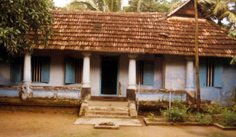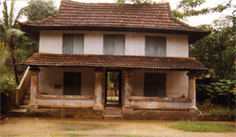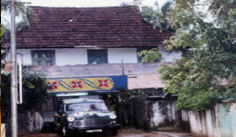Cheruparambath is an ancient Nair family in the old Cochin State and has a history dating back nearly 250

years. The family has about two hundred fifty members with their descendants and links, spread far and wide in Cochin, Kerala, other states in India and abroad. The original Cheruparambath ‘tharavad’ (home stead) was built nearly one hundred and fifty years ago. It is located in Ernakulam at Kadavantra desom. The tharavad house is of ancient architecture with ‘Nalukettu’ having wooden granaries(‘arra’) on one side, a central pooja room, five bed rooms around, vadakkini/ kitchen halls, the central court yard etc. The ‘kudumba’
deity was worshiped in the puja room. There existed an underground cellar where valuables could be kept safely, which also doubled as a place of shelter in an eventuality.

The typical ‘padippura malika’ in front of the tharavad house was a status symbol, permission for the construction of which was a privilege extended only to the favoured few under the reign of the Maharaja of Cochin. An additional malika house existed at the southern side known as ‘thekethil malika’ with padippura, kalappura (for threshing of the harvested paddy), wooden granaries kept on the ground floor, kulappura (bathing ghat) etc. The tharavadu house stood at the center of a vast compound with verdant greenery and ‘Sarppakavu’ under many a group of giant trees like Ayani, Elanji and Ficus and these environs, dotted with age old fruit bearing trees like mango and jack fruit, as also coconut and arecanut palms, were literally a paradise for the youngsters. There were many wells, big ponds each exclusively for various purposes like drinking, bathing, washing, for rain harvesting etc and narrow

interconnected drains (thodukal) for irrigation as well as for draining the storm floods etc. The family owned and enjoyed undisputed possession of vast landed properties and cultivable lands. It stretched from the eastern Vytila canal to Chilavannor area near the Ponneth temple, scattered areas in and around Kadavanthara in the south and areas south west of Kanathu parambu near the Elamkulam temple. The whole area on the eastern side visible from the courtyard of the tharavadu was a vast stretch of paddy fields with a few home stead in between. These home stead (thatched huts) were allotted for ‘kudikidappu’ (tenants of various caste/communities most of whom were agricultural labourers).Agriculture and farming were carried out in these fields till late as 1960s.
Now, in its place huge commercial buildings and flats have come up. With this as the background there are as many as fifteen smaller independent houses around the tharavadu area, built by the individual members who have formed their nuclear families. The locale is in Kadavantra, off the Sahodaran Ayyappan Road and the adjoining road built during 1969 which itself is named Cheruparambath Road.
HISTORICAL BACKGROUND
As we travel back in time zone through the mists of the past, the first face rising before us in hazy outline is that of Cheruparambath Kunjikrishna menon (circa 1825), the grand patriarch of the matrilineal family. Legend has it that this revered figure, pining for a female offspring in the family, took his only niece (Nani was her name) in her childhood to the illom (house) of Azhuvanchery Thamprakal and offered worship before the Illom’s
deity. (It is said that their journey to that distant illom, nearly 200 miles away was remarkable as the Karanavar had to hoof it out carrying the child on his shoulder and at times on bullock cart etc.) Their efforts did not go in vain. Nani soon got married to Ammunni Menon* of Tripunithura Elamana Madom. (*Ammunni Menon was the son of a ‘Nethiyaramma’ in Elamana Madom and born to a Raja of the ‘Cochin Raja Vamsam’.) The couple – Nani amma/Ammunni menon - was blessed and richly gifted with a succession of fourteen children - ten females and four males. The present Cheruparambath family has branched out from them, their daughters, their children, grandchildren, and descendants.(Click to view the Root Thavazhi tree)
Nani Amma had one younger brother named Kunjan Menon. He had great visions. He was endowed with the reading habit and took great care in giving his nephews and nieces a proper education subject to the local customs in force during those old days. It is said that he even corresponded with eminent personalities like Dr Herman Gundert. As a ‘Karanavar’, he was very considerate and loving which is evident from the pages of the partition deed executed in 1096 (ME). His share of assets was distributed amongst his nephews and nieces. It is said he preferred to stay in the Thekkel malika after the partition. It was during his period that the last ‘kettu-kalyanam’ was celebrated in Cheruparambath family. (Kettu-kalyanam was a custom zealously observed in ancient Nair family). The then children namely Kavutty, KochuNarayni and Ammu had this rare privilege of ‘kettu-kalyanam’. The so-called bridegroom, a ‘Thirumulpadu’ was escorted into the household perched atop an elephant and had tied the ceremonial knots! A feast that lasted for three days was part of the ceremony celebrated with pomp and fanfare!
Some of the old stories handed down through generations are interesting.:
Once the Maharaja of Cochin was having his ceremonial horse ride from Tripunithura to Kochi. Noticing the vast paddy fields on the way lying fallow, he enquired the reason and about its ownership. Our grand patriarch boldly and smartly presented himself before the Maharaja who half in fun and half as a serious challenge asked the Karanavar whether he could fill the fields with paddy sprouting before his (King) return journey. The Karanavar having boundless faith in his capacity and resourcefulness, agreed in a jiffy. Deploying his pulaya-labour force, he brought sufficient quantities of sprouting from distant eastern regions and planted them in rows in these fields. Supremely pleased to see the green fields on his return and convinced about the Karanvar’s commanding power and determination, the Maharaja ordered tax exemption for the family’s paddy fields.
On another occasion for accomplishing a certain task, the Maharaja had rewarded the family with a sword and the social status to ‘sit on grass mat’ (‘pulpaya’). (Those were days when ‘pollution’ was observed even as between Nairs of various groups; only those enjoying high status were entitled to sit on grass mats.! (‘Pulpaya, thazhzpaya’ etc were the grading factors !)
Piety and implicit observance of age old customs – these have been our family’s hallmark. It is said that Sri Ammunni Menon had died on a Thiruvonam day. On every ‘Sraddha’ day all those in the third generation used to gather together and after performing the ‘Sraddha’ rites, used to take part in the Onam feast arranged in the tharavad. Such get togethers were also arranged on the Sraddha day of NaniAmma which falls on the Ayilyam day of Kanni.
 Ponnethu Bhagavathi has been our family
deity all along. The partition deed makes a mention about various ‘Dharma Daivangal’, Naga Gods etc. enshrined in the plots devolving on the different thavazhies and the responsibilities for performing periodical annual rites/poojas also at the nearby temples namely Ananthapuram, Elamkulam Kavalkkal, Ponnethu and Ernakulam Shiva temple.
Ponnethu Bhagavathi has been our family
deity all along. The partition deed makes a mention about various ‘Dharma Daivangal’, Naga Gods etc. enshrined in the plots devolving on the different thavazhies and the responsibilities for performing periodical annual rites/poojas also at the nearby temples namely Ananthapuram, Elamkulam Kavalkkal, Ponnethu and Ernakulam Shiva temple.















